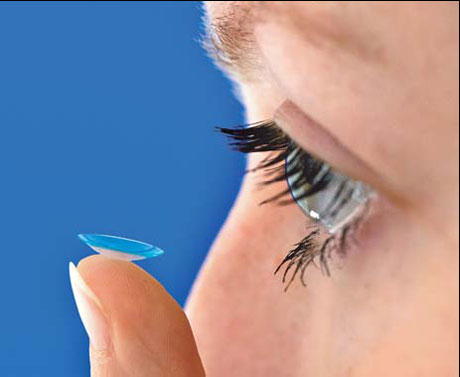Getting a clearer look at lenses
(China Daily)
Updated: 2010-08-25 09:39
 |
Large Medium Small |
Clear and focused vision without the aid of spectacles is the dream of most nearsighted and farsighted people.

Good and bad points emerge when viewing contacts as an alternative to
eyeglasses or surgery. German Press Agency
Aside from the aspects of glasses fogging up in winter and fashion, there is also the practical side: People without spectacles have a wider field of vision, which is very useful when driving for example. But due to the high cost and risk factors associated with eye laser treatment most people opt for contact lenses.
"Contact lenses can correct most forms of defective vision, including farsightedness," explains Gerald Boehme, from the Professional Association of German Opticians.
Contact lenses can be very effective, but it can take some time to have them fitted. An optician can prescribe contact lenses as well as any eye specialist, but only an ophthalmologist can say whether the eyes are healthy enough to accept the lenses. It can take up to two hours to fit the first set.
There are two types of contact lens - soft and hard. However, the term "hard" no longer fully applies to modern lenses, according to the German Consumer Protection Association, which recently released a guidebook on the subject. The lenses feel "hard" and "soft", but today's lenses are made of special plastics that make them more flexible.
The question of which type of lens you need is answered during the first examination, in which eyesight, the curvature of the cornea and the eye's tears are tested.
It also depends on what the lenses are used for: Will they be worn all day from getting up in the morning to going to bed at night or just at certain times, such as when playing sports, or just a few times a week?
Lenses can also be "permanent" or last for just a few days. Disposable lenses make up the majority of the market, the most popular being those that can be worn for up to four weeks.
"Disposable lenses are only suitable for 75 percent of all forms of defective vision," says contact lens expert Volker Grahl, from the industrial association, Spectaris. They also require as much care as conventional lenses and only offer a better value when they are used infrequently.
Experts advise that hard lenses make the most sense for the pocket in the long run. Hard lenses float on a film of tears, which allows a supply of oxygen and essential nutrients to pass to the eyes. Disease-causing germs and chemicals have hardly any chance of sticking to a hard lens and, therefore, can't harm the eye. Hard lenses, however, do have a limited lifespan of 18 months. In most cases, the lenses are custom made for each eye.
"Soft lenses are the choice of second resort if they are intended to be worn every day," Boehme adds. But soft lenses are easier to get used to, and if you are in a dusty environment, they cause less irritation. Soft lenses can be used for up to a maximum of one year.
In addition to the cost of buying the lenses, you must also calculate in the care products you will need.
"You always need to have a pair of spectacles as an emergency replacement," Boehme says.
That's because if an infection appears, or you develop red eyes during a cold, you should take out the contact lenses. Otherwise, you may end up causing permanent damage to your eyes.